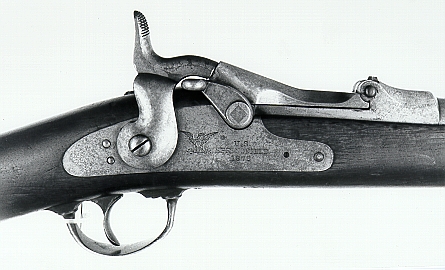Model 1873
Model 1873 Rifles, Carbines and Cadet
Rifles
Model 1873
Rifle | NRA Very Good=$900
NRA Excellent=
$2,200 |
Model 1873
Carbine |
NRA Very Good=$1,500
NRA Excellent=
$3,500
Custer range= $4000+ |
Model 1873
Cadet Rifle | NRA Very Good= $800
NRA Excellent=$1,200 |
Model 1873 Rifle
| Overall Length | 52" |
|---|
| Barrel Length (in bore) | 32.6" |
|---|
| Cleaning Rod Length | 35 9/16", 3" of Cannelures
|
|---|
| Muzzle Diameter | .73" |
|---|
| Rifling | 3 Lands and Grooves |
|---|
| Caliber | .45 CF .45-70-405/500 Cartridge |
|---|
| Barrel Bands | 2 |
|---|
| Cartouches | 1, Oval ESA, Oval ESA/Date, or Rectangle
SWP/date |
|---|
| Breech Block | Model/1873/Eagle/Arrows/U.S. or
U.S./Model/1873 or 1884 |
|---|
| Firing Proof | Circled Script P |
|---|
| Lock Plate | Dated 1873 or undated |
|---|
| V/P/Eagle/p stamp | post SN35,000 |
|---|
| Serial Number | Receiver |
|---|
| Rear Sight | M73, M77, M79, M84 |
|---|
| Front Sight | 1 1/4" from muzzle, 5/16" long |
|---|
Model 1873 Rifle & Carbine
The following information is taken from: Desription and Rules for the
Management of the Springfield Rifle, Carbine and Army Revolver, 1874.
During the year 1873, the Board of Officers appointed in pursuance of the
"Act of Congress, - approved June 6, 1872 - for the purpose of selecting
a breech system for the military service of
the United States," reported in favor of the "Springfield" system.
The minor details as to the caliber, form of chamber, ammunition, etc.,
were also determined by a Board of Ordnance Officers convened for that
purpose. In the following pages will be found a full description of this
system in all its details, as adopted by the War Department.
The Springfield Rifle, Carbine .45", is essentually similar to the
"Springfield Musket, Model 1870," which for some time
past has been in the
hands of troops for trial. The following changes have been made:
- 1st. The barrel has been made of low steel instead of iron, and the
caliber has been reduced from .50" to .45". The rifling consists of three
plain concentric grooves equal in width to the lands, .005" deep, with a
uniform twist of one turn in twenty-two inches.
- 2nd. The lock plate has been reduced in thickness, and has no bevel on
the edge.
- 3rd. A rounder shape has been given to the hammer.
- 4th. The heads of the tang screw, tumbler screw and side screws have
been rounded off, and the side screws have been slightly shortened.
- 5th. A screw has been substituted for the rivet of the guard bow
swivel.
- 6th. The shape of the rear sight has been changed, and it has been set
further forward on the barrel.
- 7th. The metal parts of the rifle have been browned or blackened.
- 8th. The stock has been rounded off near the lock plate, and on its
upper edges, as far forward as the lower band.
- 9th. A number of cannelures have been cut near the small end of the
ramrod, in order to give a better grip to the fingers in using it.
- 10th. The shape of the upper band and of the gun sling swivel have
been changed, and an open or stacking swivel has been added for the
purpose of stacking arms without using the bayonet.
The changes in the carbine follow those above indicated in the
description of the rifle.
For additional photographs, descriptions and
specifications see:
The .45-70 Springfield-Book I or The
.45-70 Springfield-Book
II-1865-1893.

